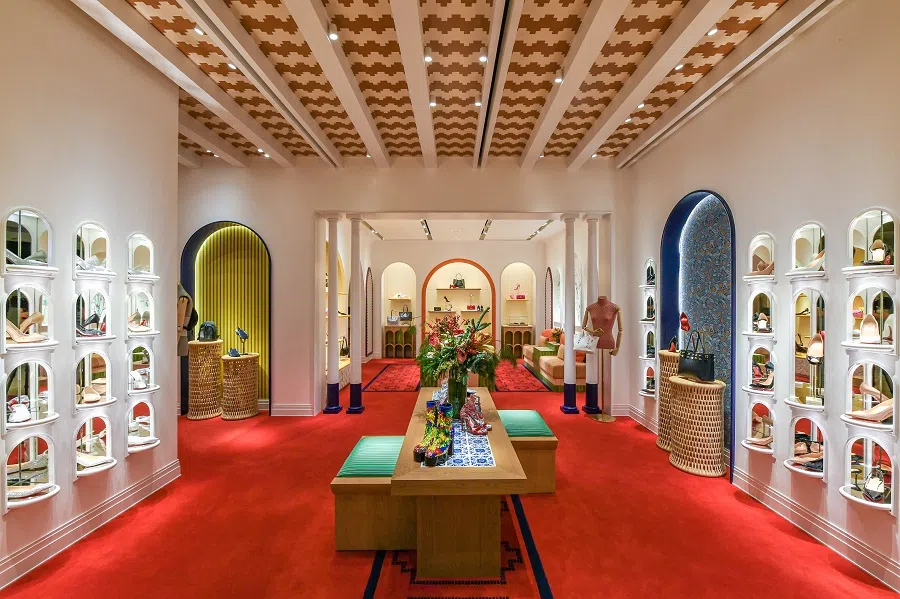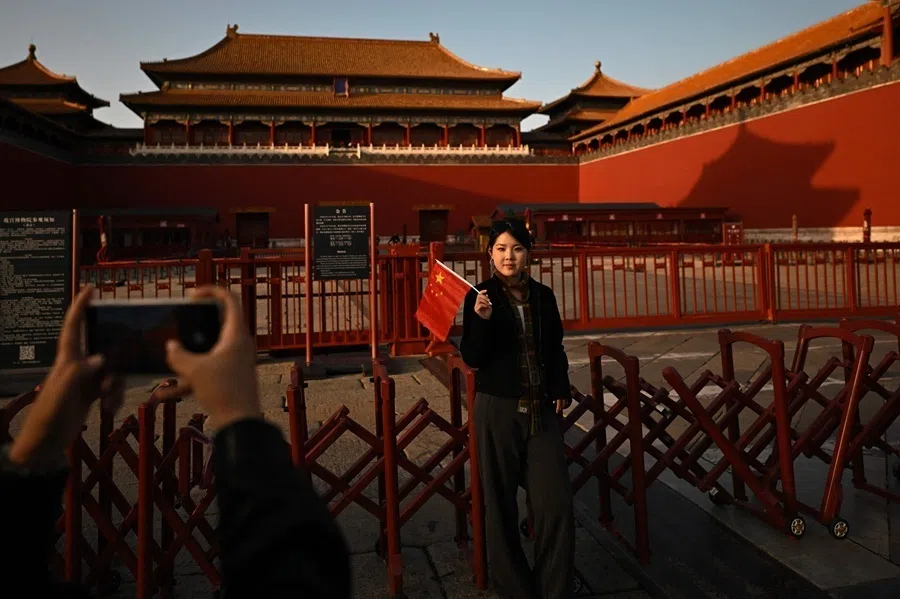Louboutin's famous red-soled heels tread winding path to trademark protection in China
In 2012, Christian Louboutin shoes made their debut in the Chinese market, two years after an application to have their distinctive appearance protected under the Trademark Law sparked a legal tussle that would unfold over the ensuing decade and continues today.

(By Caixin journalists Tao Yuyan, Ge Xinghang and Guo Xin)
Around 31 years ago, renowned French footwear designer Christian Louboutin drew inspiration from his assistant's red nail polish to create the iconic red-soled high heels that would captivate the fashion world. The unique shoes evolved into the hallmark of his eponymous brand.
In 2012, the shoes made their debut in the Chinese market, two years after an application to have their distinctive appearance protected under the Trademark Law sparked a legal tussle that would unfold over the ensuing decade and continues today. It serves as an example of the complexities in negotiating the system designed to protect intellectual property (IP) in China and what symbols qualify for protection.
The issue has been a major thorn in the side of foreign and local fashion brands in China, where names such as Hermes, Christian Dior and Hennes & Mauritz AB have been embroiled in IP disputes in recent years. Indeed, a 2020 survey conducted by the China Fashion Industry Intellectual Property Conference showed 60% of designer brands said they had been plagiarised, and 25% were aware of counterfeit versions of their work, according to an article in Vogue Business.
The costs of plagiarism can add up in a personal luxury market forecast to be worth 460 billion RMB (US$63 billion) in 2024, representing a year-on-year growth of 4% to 6%, according to Business of Fashion and McKinsey & Co.'s latest State of Fashion report. Those figures would outpace both Europe on 3% to 5% and the US on 2% to 4%, said the report, which was released in November.
Louboutin's prolonged legal battle started in April 2010, when, based on the Madrid Protocol for International Trademark Registration, Louboutin applied for the territorial extension of protection of the red sole trademark on the Chinese mainland. In October of the same year, the China Trademark Office - now part of the China National Intellectual Property Administration (CNIPA) - rejected the application for lack of distinctiveness.
The dispute regarding the permissible scope of utilising the red colour for Louboutin's red soled shoes revolves around striking a delicate balance between maintaining fair market competition and the imperative of safeguarding intellectual property rights.

The dispute regarding the permissible scope of utilising the red colour for Louboutin's red soled shoes revolves around striking a delicate balance between maintaining fair market competition and the imperative of safeguarding intellectual property rights.
That is, the more exclusive rights that are granted to a trademark or symbol, the more the products bearing that mark can be monopolised in the market, and the more obstacles there are for other businesses to match their competitors' products. This is especially so when it comes to something like a single color. Therefore, protection must be given cautiously.
The key to signs protected by the Trademark Law lies in their "perceptibility", Yao Huanqing, an associate professor at the Intellectual Property Academy of Renmin University of China, told Caixin. According to this view, the combination of colour and position embodies perceptibility.
This should have augured well for the red-soled heels. After all, Louboutin's rise to one of the world's most accomplished fashion designers was due to his distinctive sense of style. But the road to "perceptibility" under Chinese law was to be long and tortuous.
Hailing from a working-class family in Paris, Louboutin was born in 1963 and exhibited early signs of shoemaking prowess and creative flair. In 1988, he joined the Roger Vivier shoe company under Christian Dior, and in 1991, he founded the eponymous brand and company, Christian Louboutin SA, specialising in shoes, leather goods, gloves and gifts. The red soled high heels emerged as the company's flagship product.

As early as 2007, the brand's red sole secured trademark registration in the UK. According to the application document disclosed by the World Intellectual Property Organization (WIPO), the trademark consists of the colour red - labelled Pantone No. 18.1663TP - applied to the sole of a shoe as represented in the mark, while the outline of the shoe was not included.
Given the international recognition of its trademark design and color, the French luxury brand refused to accept the China Trademark Office's rejection and filed an application for reevaluation with the office's Review and Adjudication Board (TRAB).
But in January 2015, the TRAB rejected the application, saying that the claimed trademark consisted of a commonly used high-heeled shoe graphic and a single colour for the sole of a shoe, which lacked distinctiveness.
The company escalated the matter by filing an administrative lawsuit and scored a win, at least temporarily.
In December 2017, the Beijing Intellectual Property Court delivered its initial ruling, highlighting that the TRAB had erroneously categorised the contested trademark merely as an article brand or device, overlooking its classification as a three-dimensional (3D) trademark representing the shape of high-heeled shoes, accentuated by the application of red colour in specific areas.
Emphasising the assessment of the 3D mark's distinctiveness through evidence such as consistent commercial promotion and corresponding sales, the court overturned the TRAB's initial refusal.
Diverging viewpoints among judicial and administrative authorities have led to a deadlock in the trademark registration process for Christian Louboutin's red-soled shoe.

This conclusion was made under the auspices of Article 8 of China's Trademark Law. This law stipulates that any sign capable of distinguishing the goods of a natural person, a legal person, or any other organisation from those of others, including but not limited to word, design, letter, numeral, three-dimensional symbol, combination of colors, and sound, as well as a combination of the above, may serve as a trademark for registration application.
The TRAB sought to overturn the ruling and lodged an appeal with the Beijing High People's Court, but in December 2018, the court issued a verdict, upholding the prior ruling to overturn TRAB's decision and instructing a reevaluation of the mark's distinctiveness.
In November 2018, the functions of the China Trademark Office and TRAB were consolidated and delegated to the CNIPA. Subsequently, the top IP rights regulator sought a retrial from China's Supreme People's Court.
A culmination of sorts in this legal saga occurred in December 2019 when the Supreme People's Court delivered its verdict, affirming the decision reached in the appeal, thereby dismissing the CNIPA's plea for a retrial.
No end in sight
However, it was not the end of the matter. Diverging viewpoints among judicial and administrative authorities have led to a deadlock in the trademark registration process for Christian Louboutin's red-soled shoe.

According to details shared with Caixin by Louboutin's attorney, the registration process for the red sole continues. The most recent findings from the China Trademark Office, dated 28 July 2023, indicate that the current status of the process is marked as "under rejection review".
Facing a standstill in the registration of unknown duration, Louboutin took matters into its own hands and pivoted towards targeting a company that it alleges had copied its unique shoe design.
In 2020, Louboutin, along with its subsidiary CL Shanghai Ltd., initiated legal action by filing a lawsuit against Guangdong Wanlima Industrial Co. Ltd. and its distributor Beijing Yi Xi New World Department Store Co. Ltd., alleging unfair competition.
Established in April 2002, Wanlima is a leather goods manufacturing company that went public on the Shenzhen Stock Exchange's Growth Enterprise Market in 2017.
Louboutin's primary legal grounds for suing Wanlima were rooted in Article 6 (1) of China's Anti-Unfair Competition Law. This particular provision prohibits a business from using, without authorisation, any mark identical or similar to the name, packaging or decoration of another business entity's goods that has certain reputation.
Ultimately, at the core of the issue is the Trademark Law.
On 30 August 2022, the Beijing Intellectual Property Court ruled in favour of Christian Louboutin. It ordered Wanlima to cease manufacturing and selling women's high heels with product names and red soles identical or similar to Christian Louboutin's red-soled shoes.

Moreover, Wanlima was instructed to indemnify Christian Louboutin for economic losses amounting to 5 million RMB, coupled with reasonable expenses totaling 445,000 RMB. In an effort to rectify the impact of unfair competition, the court mandated Wanlima to issue a corrective statement on its official website and official Weibo account.
As for New World Department Store, it was directed to reimburse Christian Louboutin for reasonable expenses totaling a mere 5,000 RMB.
In September 2022, Wanlima appealed to the Beijing High People's Court. Caixin has learned that, after more than a year of legal deadlock, the two parties recently reached a settlement. Despite multiple attempts to obtain information from Christian Louboutin regarding the resolution, Caixin did not receive a response by time of publishing.
Ultimately, at the core of the issue is the Trademark Law.
Since its inception in 1982, the existing Trademark Law has undergone four revisions. In January 2023, the CNIPA unveiled the draft of the fifth amendment, inviting public feedback. While the specific details of this amendment remain opaque, scholars interviewed by Caixin indicated a general inclination toward a gradual expansion of the permissible types of trademarks that can be registered.
For Louboutin, it means more time spent cooling its heels while they wait for official IP protection to be granted under Chinese law.
This article was first published by Caixin Global as "In Depth: Louboutin's Famous Red Sole Heels Tread Winding Path to Trademark Protection in China". Caixin Global is one of the most respected sources for macroeconomic, financial and business news and information about China.





![[Vox pop] Chinese parenting: Tough love or just tough?](https://cassette.sphdigital.com.sg/image/thinkchina/b95bd53631df26290df995775a40e36709bf8dc8e3759460276abd5c426b20b6)